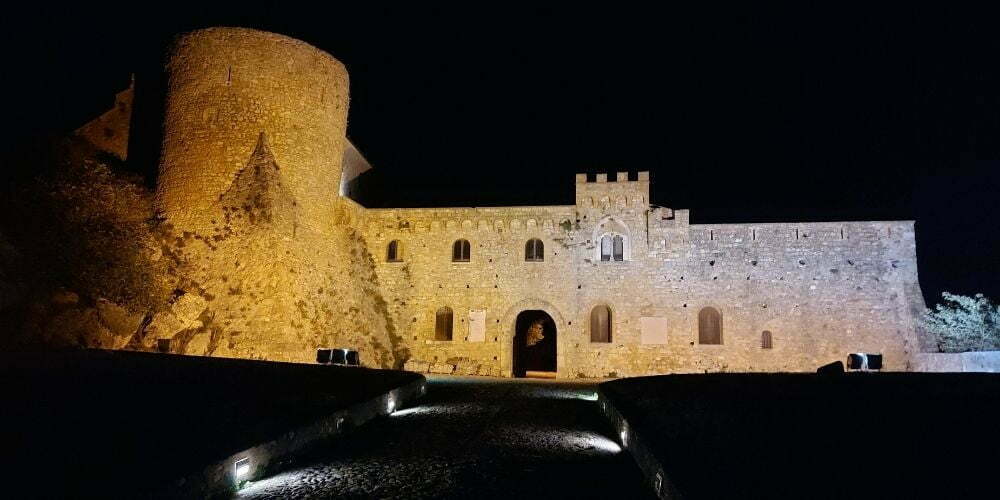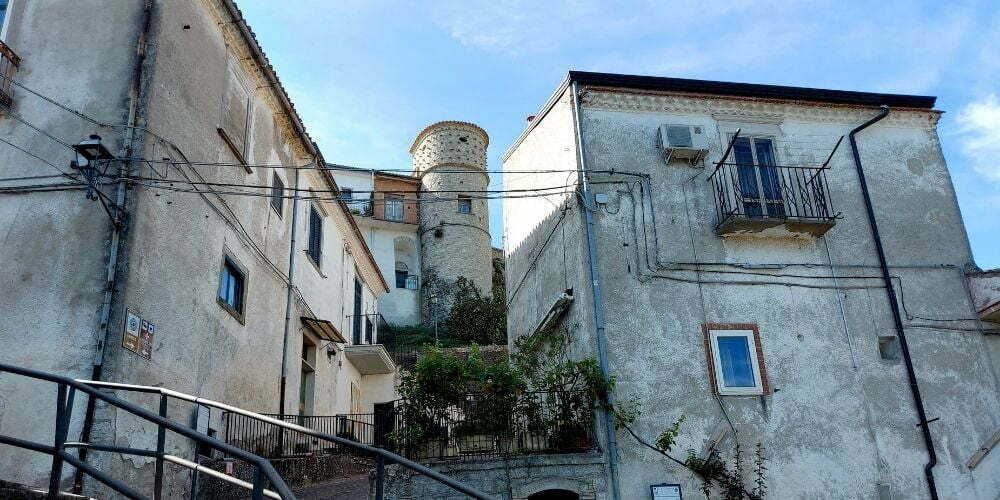In the hotly popular Italian region of Apulia, one stunning area has often been overlooked. Let us make you discover the Daunian Mountains…
What & How of the Daunian Mountains
The area is home to more than 500 churches and dozens of castles. And with its rolling hills and orderly fields of grain, oats and other crops, the Monti Dauni looks almost Provençal. It is like an oasis between the lowlands of industrial city Foggia and the cluttered urbanization of eastern Campania. The best part is yet to come: tourists are easy to spot and the residents are authentically nice.
Before we start our tour through this area, and we’ll dish up the highlights, first a few basic questions about the area:
Where are the Daunian Mountains located in Apulia?
The Monti Dauni or Daunia are located in the north of the Italian region of Apulia (also spelled ‘Puglia’). The 30 small municipalities in this mountainous area belong to the province of Foggia. On the east side, the area borders with Campania (capital: Naples). The total area is almost 23,000 square kilometer (890 square mile). Its highest peak is 1100 meters above sea level.

Why should I go to the Daunian Mountains?
Apulia has become a very popular area in the last twenty years. Especially the south (the Salento region) is visited by tourists. Bari and Lecce have also been put on the map. Furthermore, Apulia is famous for its typical houses, called trulli, its gastronomy and the waters it is located on (Ionian and Adriatic seas).
Hope: The Autobiography
By Pope Francis
New York Times bestseller
First autobiography by a Pope
A vivid memory…
Get offer at Amazon.comAn undiscovered gem are the Daunian Mountains. They are probably overlooked because they are close to the lowlands of Foggia, both the city and the plains are not quite interesting.

How to get to the Daunian Mountains?
Fly to Bari. After that, it is about 200 kilometers north. Good highway connections are available. You can also go via Rome. From the international airport (Fiumicino), the car journey takes about four hours (over 300 kilometers).
The nearest base (railway station, car rental) is Foggia, at about 40 kilometers.
Also read: about the city of Foggia, which also enjoys some notoriety for other reasons

Most beautiful places in the Daunian Mountains
Here is a small list with the 8 most beautiful places in the Daunian Mountains. Hope this can provide you with some inspiration for a next Italy travel. Please let us know what you think of these spots or if you know any additional treasures in the comments below!
1. Bovino
We start our tour of Daunia in Bovino (40 km from Foggia). You would expect the town to have agricultural origins (bovino means ‘beef’), but it originated as a castle village in the early Middle Ages.

And in fact it still is. The castle at the top of the historic center was built in beautiful stone by Drogo of Hauteville, a Norman duke (12th century). You get there by car, at least in first gear, right into the courtyard. There is a good reason to do so. You can feel yourself Drogo for one or more nights. Seven large and modernly furnished rooms are rented there for the price of a 1-star hotel.
We eat at Saverio’s, who runs the ‘Osteria ndo saverie lu conte‘, a little lower in the town. It is one of those osterias of bygone days, where Saverio wears all kinds of hats. He cooks on a -what we would now call- cooking island, serves at the table and takes the time to explain which delicacies we take in. The wine (a mix of Bombino and Troia grapes – more on that later) and olive oil come from his own land and the rest also originates from the area. By the way, Saverio tells us that the origin of the name Bovino stems from the corruption of the Latin word for junction.

Bovino has an interesting church that can claim to be a cathedral because the little town of 3,000 inhabitants is remarkably an episcopal city (although merged with Foggia). The Romanesque church has traces from the ninth century and, with its rather low construction, seems to have adapted to the small, picturesque square on which it sits. Inside, the church is less beautiful (modifications from the 17th century), but the baptismal font stands out. It is a beautiful composite work based on a ninth century ionic capital.

When you are back outside, you should look up. Right at the top of the church, above the rose window, sticks out the head of an ox with horns. And to say that Bovino has nothing to do with oxen….
2. Deliceto
Deliceto (15 km from Bovino) also has such an imposing castle. It was built in the time of the Normans around the year 1100. You can enter it under guided visit. The castle has been restored and has large empty spaces ( they guarded here and did not live here, says the guide). The best is the view from the square tower, on which, by the way, an original manufactured Italian flag ‘flutter’.

On the main street leading down from the castle, we accidentally run into Benito. He is the talkative baker of the town and spontaneously invites me for a tour of the bakery. He introduces his two brothers and mother, who all work in the business. Bread baking is the same everywhere, but Benito gives an extra twist to the craft. Just before a number of loaves go into the oven, he makes almost theatrical vertical cuts in the dough with a knife. This gives the bread its characteristic structure when it is crisp and fresh from the oven.

3. Sant’Agata di Puglia
A castle also towers over Sant’Agata di Puglia (25 km from Deliceto). The place was founded by the Romans to control the Via Appia, the road from Rome to Brindisi. The Romans named this castrum, a fortified army camp, after the goddess Artemis. In the year 592, the place was renamed after another woman with the letter A: Agatha.
The town was an important place for a string of conquerors because it is strategically located on a hill, where you can see the enemy coming from dozens of miles away.

Halfway up the hill of this mountain community is the Church of St. Andrew. It is built in light-colored stone and is located on a small square that can only be reached by stairs. Small church squares seem to be a characteristic of Daunia. A little higher, at the highest point of the town, is the imperial castle built by Charles I of Anjou, among others, which has a beautiful entrance portal.
That gate is closed because it is noon. At the entrance stands a woman. You sense that she is standing there with a purpose. When we speak to Antonia, as she is called, she tells us that she is an ‘avvistatore’. That is someone who stands guard. Could the Saracens still be threatening the inland? Thankfully not, but there is something else dangerous. Antonia stands there to locate forest fires at an early stage.

As Antonia walks with us around the castle, she explains that she and three other colleagues are scanning the area on other high peaks of Monti Dauni. If they detect anything like fire, they have to call an emergency number in Bari. Boy, would modern technology have passed Sant’Agata by? On the nearest hill, opposite Sant’Agata, things went wrong 3 years ago. It’s all black there. That day Antonia was not present.
4. Alberona
Alberona is one of the four ‘borghi più belli d’Italia‘ in Daunia (a label for beautiful villages). The village consists mainly of characteristic houses along alleys and stairs. The main monument in the village is the Torre del Priore, which once belonged to the Knights Templar.

The knights of this medieval order with their characteristic white cloaks with a red cross were well represented in Apulia. This was due to the fact that Apulia lies on the southern Via Francigena, the pilgrimage route to the Holy Land. The rich order of the Knights Templar was dissolved by Pope Clement V in 1312. This was preceded by a gruesome persecution of the knights. The abrupt end to this order gave and still gives rise to legend.
After the Templars, the Maltese Knights, another Catholic order that guarded Christian sites in the eastern basin of the Mediterranean, gained the upper hand. In the 14th century, the Grand Master of this order brought his seat to the Torre del Priore.

It cannot escape your notice that the Knights Templar belong to Alberona. You will rarely see their logo so often, that red cross on the white field. So too in the B&B ‘I templari di Alberona’: all kinds of Templar paraphernalia, a harness and the rooms have names like ‘cross’ and ‘grandmaster’. We are assigned the knight’s room (‘cavaliere’). The room has a high tapered masonry ceiling. Inside it is like a squashed trullo. The owner of the B&B is also the mayor of the town.

On the promenade with again such a wide view that is so typical of the Monti Dauni, in the early evening the villagers gather for the traditional struscio, where people seemingly walk aimlessly, meet and chat with each other. A wide pedestrian corridor has been constructed, which for once is not dedicated to the Templars, but to Giacomo Strizzi (1888-1961), a local poet who wrote in dialect and enjoys a certain fame in Italy.
5. Roseto Valfortore
Roseto Valfortore is 10 kilometers from Alberona and is also on the list of the ‘most beautiful villages of Italy’. It owes this to the beautiful Santa Assunta church (1507), which here too is sandwiched between other buildings. The church is packed. It is just the Sunday before the first day of school. At the end of Mass, all the children present come to the altar and bring their school bags as high above their heads as possible. The priest blesses the bags with holy water. It’s a happy and colorful ‘mess’.

Roseto is located in a large forest, where truffle hunting is also practiced. Roseto is also known for its water mills and the extraction and processing of natural stone.

6. Celle San Vito
Leaving Roseto, we head to Celle di San Vito, an extremely small municipality (100 inhabitants). Of course it is again situated on a hilltop, but the most interesting thing is actually the language they speak there. Upon entering the town, it becomes immediately clear.

A derivative of Provençal is spoken here. Its origins go back 800 years when Provençal mercenaries were hired by Charles of Anjou (King of Naples and son of the French king). A contingent remained. That’s what Maria Angela tells us, whom we meet on the windy main street (Via Roma), while her one son is playing soccer.

7. Biccari
That Provençal touch remains. In Biccari (15 km further on) we meet 32-year-old Filippo Sabatino, a modern farmer who makes truffle products and has also planted two hectares of lavender. The lilac is arranged in beautiful rows. It is at the foot of Monte Cornacchia (1150 meters), the highest peak in Daunia.

Biccari is sometimes called Little Switzerland, because it is surrounded by almost 300 hectares of forest (and I assume because an occasional snowflake falls there in winter). On the way to Monte Cornacchia you pass a small lake that in summer is covered with water lilies and, according to nature lovers, is a rather rare biotope.

8. Troia
Troia (20 km from Biccari), named after the ancient Troy, is the one to largest municipality in the Monti Dauni with 7000 inhabitants. In terms of applied art, it is also the most important. The cathedral, named after Mary Assumption, is a masterpiece of Romanesque sculpture. The 12th century rose window is an absolute must-see. Books have been written full of its theological and cosmological significance. Let’s just say that it is perhaps the most beautifully designed rose window in Italy.

Troia is also the birthplace of the Italian Prime Minister Antonio Salandra, who in 1914 dragged Italy into World War I. Some members of parliament afterwards ambiguously called him “illustrious son of Troia”, referring to the other meaning of troia (‘whore’).

The Troia grape is increasingly used in wines from Puglia, whether blended with the Bombino grape or not. The ‘nero di Troia’, so called because the grapes are violet in color, form wines with a strong bouquet of “figs, black pepper and cloves” to quote Luca Maroni, a well-known Italian wine publicist.
Extra: The murales of Stornara
A greater switch is almost impossible to imagine. The lovely mountains and the picturesque villages of Daunia versus the concrete, the unfinished and the impersonal of a rural community in the plain near Foggia. We are talking about Stornara (50 km from Troia), a municipality that lives from agriculture. Tractors almost outnumber passenger cars. The town is surrounded by flat agricultural fields. A local Facebook group’s motto is: “If the world sucks, we can only imagine Stornara”. Do we need to say more?

We are out here because Lino Lombardi and his wife Giancarla De Marco have created beauty. The ugly concrete and unattractive streets have been given color thanks to the murales that artists have left behind for the past five years.
It started when 67-year-old Lino, once graduated from Milan’s famous Brera art academy, invited a few street art artists in 2018. The result was surprising, also for the locals, who could appreciate such cheerful paintings. That first edition was such a success that the following years continued and known artists from abroad also traveled to this gray and tiny dot in Apulia. Today Stornara is considered the Murales Capital of Apulia.

Many works are created by fairly well-known artists from the street art world, such as the Italian-Spanish Leticia Mandragora, who has the ‘blue women’s face’ as her hallmark. Dimitris Taxis, a Pole living in Greece, also has his own realistic style that is more like drawing than spraying. From South America, among others, are Colectivo Licuado (Uruguay) and Stinkfish (Mexico). Dale Grimshaw is a well-known English artist whose work often features natives, particularly the faces of West Papuans.

The Daunian Mountains in short
Are there any mountains in Apulia?

The Daunian Mountains are the foothills of the Apennines and consist of 30 municipalities, 4 of which carry the designation ‘most beautiful village in Italy‘. Its highest peak is 1100 meters above sea level.
Where are the Daunian Mountains located in Apulia?

‘Daunia’ is located in the north of the Italian region of Apulia. This mountainous area belongs to the province of Foggia. On the east side the area borders with Campania (Naples). The total area counts almost 890 square mile.
Why should I visit the Daunian mountains?

The area is home to more than 500 churches and dozens of castles. With its rolling hills and orderly fields these mountains looks almost Provençal. In terms of food (meat, truffle) and drinks (red wine) Daunia is very interesting too.







